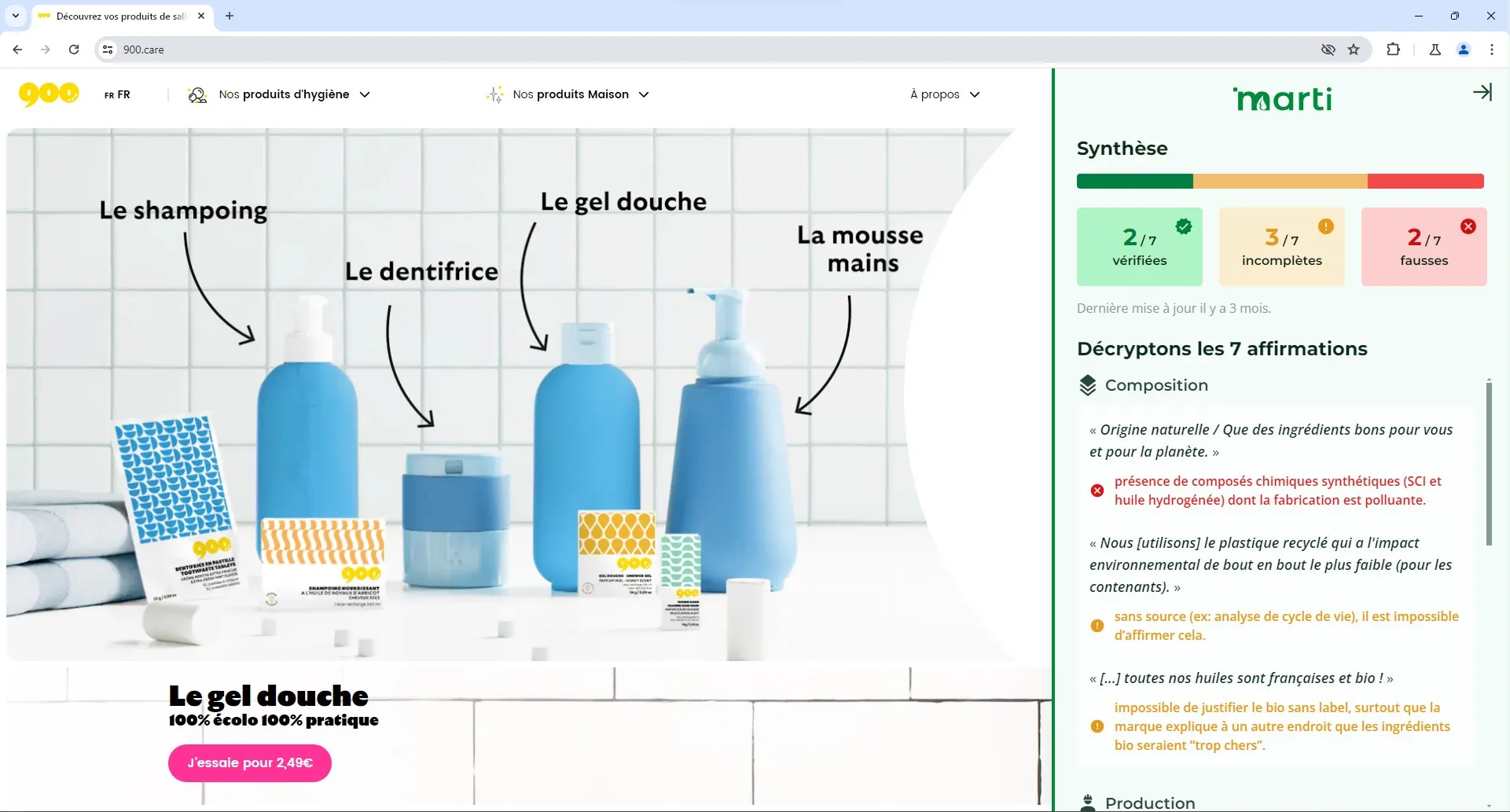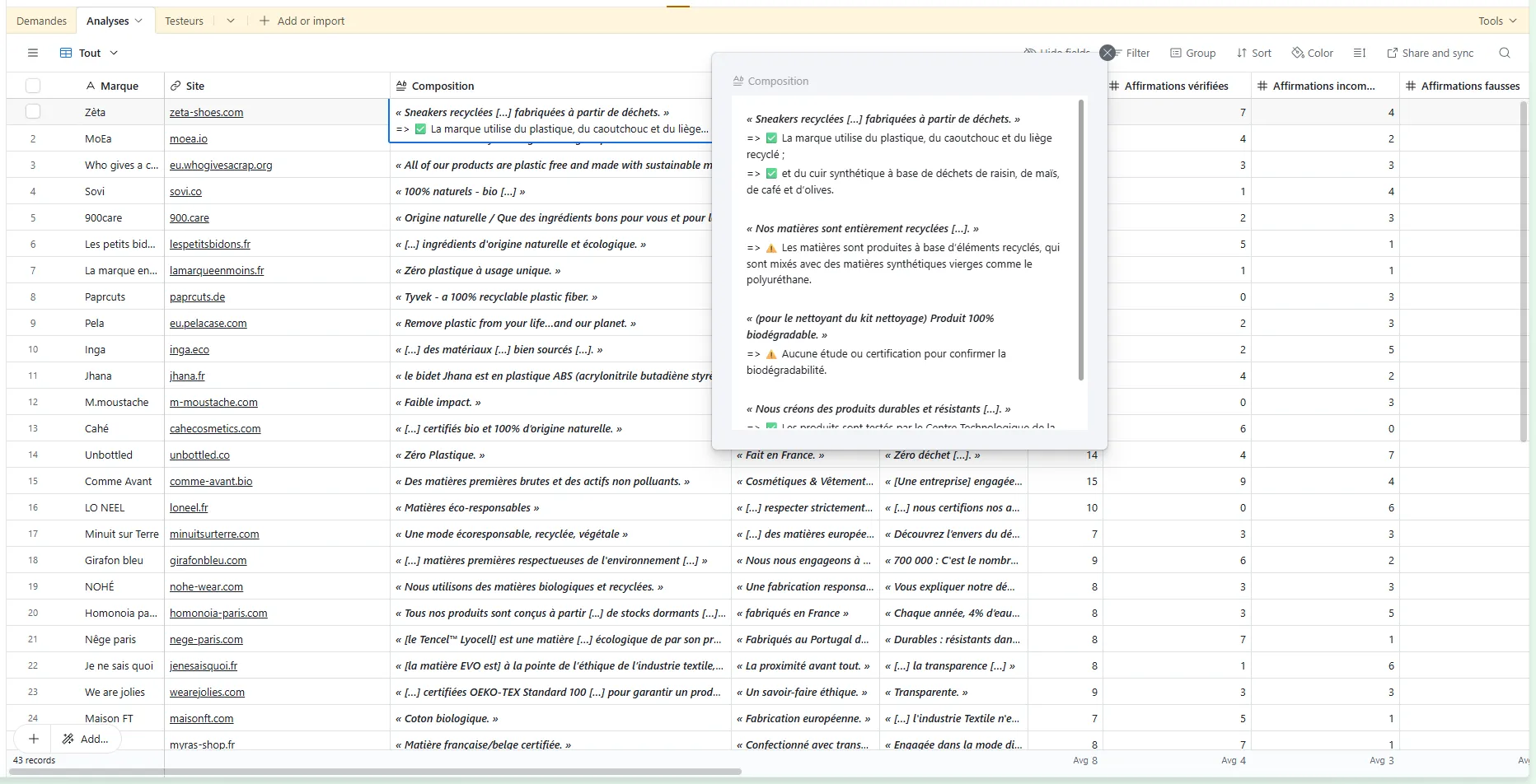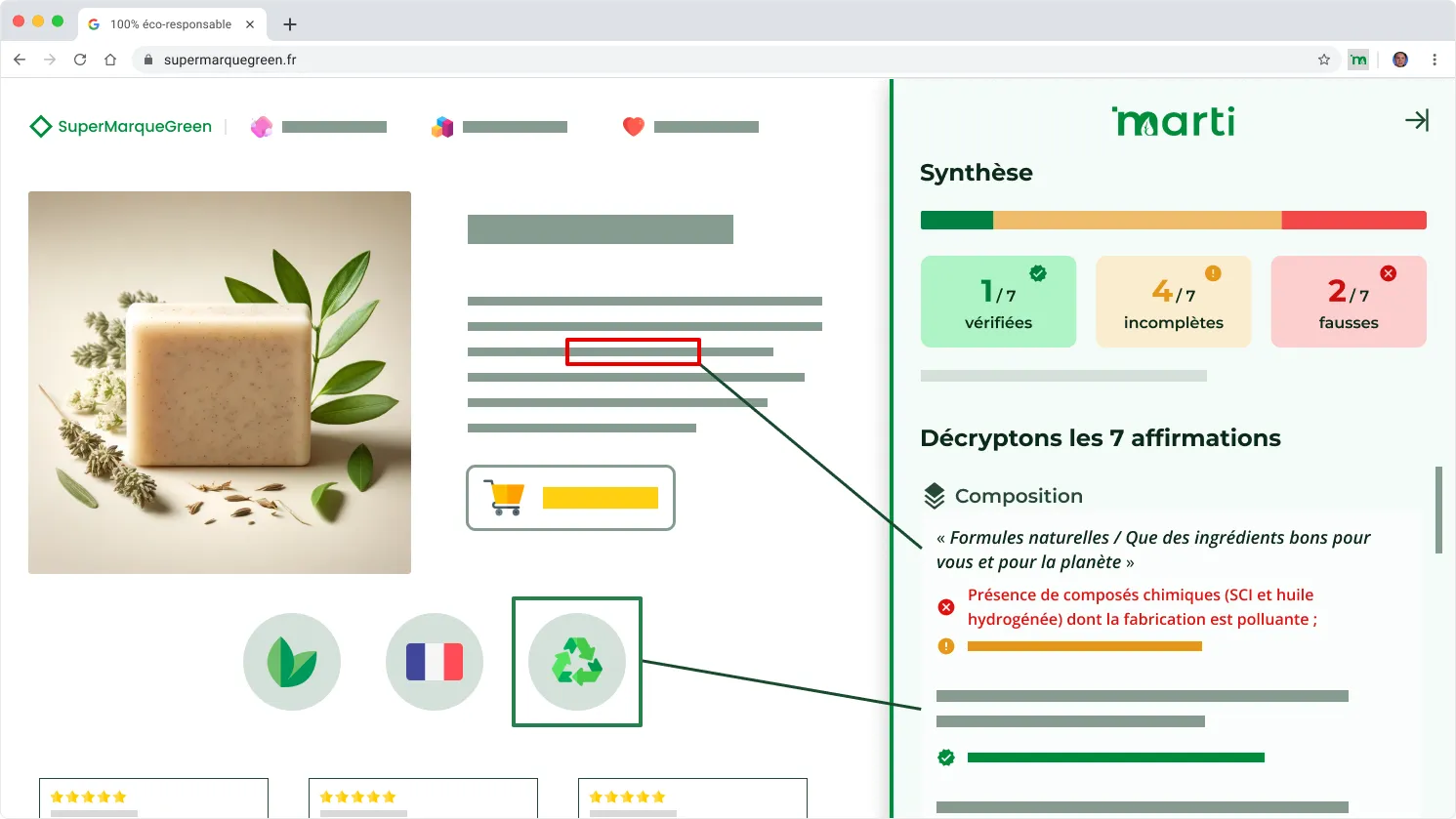Why did I make this?
This was the fourth (and last released) product of my marti startup.
The idea came to me as a necessary pivot to tackle acquisition and retention issues of v3: the marketplace.
Indeed, this type of platform needs a lot of frequent potential customer visits to do well. And mine wasn’t like the others, with a new storefront-less experience that wasn’t easy to understand for users.
This came as a brutal eureka moment: I was watching a YouTube video, and the sponsor segment presented a Google Chrome extension that claimed to analyze any ecommerce website by computing a “safety” score.
This clearly was a shady way to mine users’ data, but the idea was great: could I do it with greenwashing?.
Because I wanted only truly ecoresponsible brands on my marketplace, I had become interested in learning how to detect green bullshit in brand marketing.
The goal was clear: informing the user if the current website was greenwashing and, in that case, recommending similar products from my marketplace of curated brands. Aye! Pirate mindset it was 🏴☠️.
It really clicked because this product was more me than the “boring” marketplace: more techy, more expert/sciency, and more head-on.
Moreover, it could increase retention by literally including marti into users’ daily browsing routine.
Finally, it was a strengthening of the company mission: redirect conventional consumption to a more eco-responsible one.
The start
I had this idea a couple of days into end-of-year holidays (oops, so much for a break), so I quickly jumped into my design software to make a quick draft that helped visualize this new product in the last days of 2023.
Then, I drafted the user journey and identified multiple cases (invalid, unknown, and known websites…). I surveyed the market by searching for existing alternatives and trying them.
As I was now absolutely indoctrinated converted to the Lean Startup principle of minimizing waste and maximizing value, I set out to build the most minimal Wizard-of-Oz MVP :
- The extension shows up as a bubble on ecommerce websites.
- The user can click on it and ask to verify this site.
- I manually check the marketing and write the analysis.
- The user receives a browser notification when it’s done.
- They can now view the analysis when opening the same website.
Moreover, I would only support fully eco-conscious brands first because it was easier to analyze them as they were already trying their best to prove their sustainability.
You can see there wasn’t the recommendations feature. I wanted to first check the relevance of my greenwashing analyzes.
It was a bad idea because at that time, my main idea of generating revenue was through these pirate recommendations, and I should have tested that first.
This was also intentionally not scalable at all. But it was designed to quickly learn what would work and what would not.
Design prototype
I started the development phase by writing the analyses of 2 brands I already knew, one with clear greenwashing in its marketing, and the other with mostly verified claims.
Then I “packaged” these into a design prototype that I showed to a couple of existing users and friends who were trying to buy from more sustainable brands.
We jumped in a short Google Meet call, and I watched them interact with the prototype while noting their feedback.
I made 4 design iterations based on the most recurring ones, until the end of January 2024.
Alpha test
I can’t remember why exactly, but I thought I had somehow validated the design, so I jumped to building the Chrome extension prototype. It took 1 month to build a v1 because I had to learn a bit (more about that in the tech section).
Next, I directly handed the prototype to test users, started treating their analyses requests, and collected their feedback in a Google Form.
Concurrently, I started wondering about possible alternate business models to the current marketplace one because of the issues I mentioned in the first section.
I explored:
- freemium (users pay for more analyses)
- paid ads (brands pay for targeted ads)
- affiliate (brands pay a fee when a user buys thanks to marti)
- consulting (brands pay for truthful marketing consulting)
- and SaaS (brands pay to integrate marti as a plugin on their site).
Of all these, only the consulting seemed quickly viable (I estimated I would roughly need 60 leads/month to be able to pay myself).
So I made a simple process:
- Users would ask me to analyze one brand through the extension.
- I would do it and send the brand an email asking for a call.
- In this call, I would present to them the analysis and my consulting service.
- 💰💰💰 (hopefully).
Moreover, I published the synthesis of the analysis as content for my Instagram account, identifying the brand.
It felt awesome because all activities (acquisition, sales, and product) were intertwined and fueled each other.
Public beta
To ramp up the number of users and analyzed brands, I started automating the acquisition process during the summer of 2024:
- Users would sign up for the beta on the landing page by leaving their email.
- I would automatically email them the extension link (published on the Chrome Webstore) with a “tester code” that acted both as an identifier and a password to ensure I knew every user.
- When they would enter their code in the extension, I could start following their usage.
My analysis methodology was pretty solid, and on average, they would take 3.75 h. I added AI to the process with a ChatGPT customGPT for each step:
- extract environmental marketing claims
- categorize them
- and “judge” if they were greenwashing or not
Because the latter was performing poorly (due to AI capabilities at that time), I still had massive manual work to verify and write a clear and concise analysis for each claim.
For brands that were already not doing greenwashing, I designed a plugin similar to Trustpilot that would embed my analysis into their website to reassure prospects and increase their conversion.
I automated the sales emailing with a custom tool that tracked openings and link clicks. I designed a compelling marketing message with the help of the StoryBrand book.
Testers were really happy with the product, and I even got interest for the plugin, billed at 30€/month.
The number of sign-ups totaled 60 users (only with organic marketing), and 14 finished the complete process (installing, asking for analyses, and giving feedback).
I wrote 43 brands analyses.
For acquisition and social proof, I was writing a LinkedIn post each week, debunking greenwashing and reacting to news (you can find them as posts on this website).
The pivot
At the end of September 2024, I had a kind of personal breakdown: we had projects with my girlfriend, but I wasn’t able to plan for the future because of my situation.
It made me realize that after 4 years of entrepreneurship:
- I needed recurring income.
- I had the impression of doing a lot of things (marketing, analyses, sales, dev…), but in reality, I was just throwing spaghetti at the wall and hoping some would stick.
- And I thought it wasn’t enough, that I needed more of everything.
Moreover, I was able to optimize my sales pitch to increase the open rate of my cold emails but haven’t succeeded in booking calls.
It seemed that this problem I was seeing (eco-conscious brands were hurting their conversion by unconsciously doing greenwashing) wasn’t really a thing for the market.
And I didn’t have anymore of the “sacred fire” to justify 3 more years of grinding a big enough community with a free product to open viable monetization opportunities.
So I decided to take a break to test a new product that could be quickly viable: an AI-powered tool to detect greenwashing for marketing agencies.
Because I wasn’t generating revenue, this break was not a problem for the company.
I didn’t know at the moment that it would be the last pivot and the last months of marti.
Main takeaways
What I learned from this project:
- How to build a Chrome extension.
- How to build compelling marketing with the StoryBrand Framework.
- The product should come from the market rather than from my unresting mind.
- Synergies between all activities of the company can be very effective for a small team and are necessary for a solo founder.
- A gated beta test is very powerful to get valuable feedback and understand testers’ experience.
I also made something useful and learned a lot about what really matters in more eco-responsible products like garments, cosmetics, and food.
Tech
Wow, lots of drama, right?
Let’s lighten the mood by being nerdy 🤓.
I can’t remember how I discovered Plasmo, but it seemed to be the best option to build Chrome extensions at that time.
I particularly enjoyed the browser-agnostic API and the ability to embed React, Vue, or Svelte code for UI.
It made the intricacies of browser extensions (background messaging, script injection…) really simpler.
I chose to learn and use Svelte for the UI of the extension, with the help of the mighty TailwindCSS for styling.
Likewise, I wrote code that would detect if the current site was an ecommerce one by looking if it was making requests to WooCommerce, Shopify, or Magento endpoints.
I also wrote a sync and cache system to store the user’s requests and analyses from the backend.
Speaking of that, I used Airtable as the database, as in the previous product, which gave me an out-of-the-box API and handy UI to manage testers, requests, and analyses.
I also used Airtable automations to streamline the acquisition (of users) and the cold mailing (to analyzed brands) processes.
To secure requests between the extension and Airtable, I used Firebase Cloud Functions to write discrete API routes that hid the Airtable API token from client code.
One of those also did the parsing logic to convert the Markdown I was writing the analysis with into the JSON format required by the extension (see images at the top).
Finally, I used my go-to tool for analytics at that time: Mixpanel.


